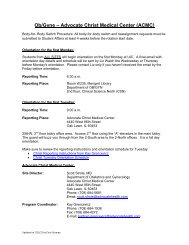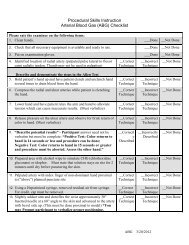a national survey of ASOPRS members. Ophthal Plast Reconstr
a national survey of ASOPRS members. Ophthal Plast Reconstr
a national survey of ASOPRS members. Ophthal Plast Reconstr
You also want an ePaper? Increase the reach of your titles
YUMPU automatically turns print PDFs into web optimized ePapers that Google loves.
ORIGINAL INVESTIGATION<br />
Current Ptosis Management: A National Survey <strong>of</strong><br />
<strong>ASOPRS</strong> Members<br />
Vinay K. Aakalu, M.D., M.P.H., and Pete Setabutr, M.D.<br />
Department <strong>of</strong> <strong>Ophthal</strong>mology and Visual Sciences, University <strong>of</strong> Illinois at Chicago College <strong>of</strong> Medicine, Chicago,<br />
Illinois, U.S.A.<br />
Purpose: To assess current practice patterns for management<br />
<strong>of</strong> ptosis by current <strong>ASOPRS</strong> <strong>members</strong>.<br />
Methods: An invitation to participate in a web-based, anonymous<br />
<strong>survey</strong> was sent to current <strong>members</strong> <strong>of</strong> the American<br />
Society <strong>of</strong> <strong>Ophthal</strong>mic <strong>Plast</strong>ic and <strong>Reconstr</strong>uctive Surgeons<br />
(<strong>ASOPRS</strong>) via e-mail. The <strong>survey</strong> consisted <strong>of</strong> 4 sections:<br />
preoperative testing <strong>of</strong> ptosis patients, surgical preferences, dry<br />
eye evaluation in ptosis patients, and length <strong>of</strong> postfellowship<br />
practice. Responses were analyzed using standard statistical<br />
methods.<br />
Results: Fifty percent <strong>of</strong> <strong>ASOPRS</strong> <strong>members</strong> performed more<br />
than 100 ptosis procedures in the past year. Most <strong>ASOPRS</strong><br />
<strong>members</strong> performed preoperative photography, automated perimetry<br />
testing, and phenylephrine testing in evaluation <strong>of</strong><br />
ptosis patients. A slight majority <strong>of</strong> <strong>ASOPRS</strong> <strong>members</strong> did not<br />
use preoperative Schirmer testing as the primary screening tool<br />
for dry eye disease. Most <strong>ASOPRS</strong> <strong>members</strong> performed internal<br />
levator aponeurosis advancement surgery, although most<br />
surgeons performing concurrent ptosis repair and blepharoplasty<br />
preferred an external approach. Frontalis sling surgery<br />
was performed using a wide variety <strong>of</strong> materials for suspension.<br />
Conclusion: Current trends in the management and preoperative<br />
evaluation <strong>of</strong> blepharoptosis by <strong>ASOPRS</strong> <strong>members</strong><br />
revealed a number <strong>of</strong> interesting common practices that are <strong>of</strong><br />
value to current practitioners.<br />
(<strong>Ophthal</strong> <strong>Plast</strong> <strong>Reconstr</strong> Surg 2011;0:000–000)<br />
The management <strong>of</strong> blepharoptosis is a complex issue. Many<br />
different methods <strong>of</strong> treating ptosis, even with the same<br />
underlying cause, exist. 1 Numerous studies have reported the<br />
benefits <strong>of</strong> different ptosis procedures. 1–3 In addition, there is<br />
no consensus on the optimal preoperative evaluation strategy <strong>of</strong><br />
ptosis patients. 4,5 Finally, the potential for worsening dry eye<br />
disease postsurgically in ptosis patients has been suggested, but<br />
controversy exists on appropriate screening measures for dry<br />
eye disease in this population. 5 We administered a <strong>national</strong><br />
<strong>survey</strong> to <strong>members</strong> <strong>of</strong> the American Society <strong>of</strong> <strong>Ophthal</strong>mic<br />
<strong>Plast</strong>ic and <strong>Reconstr</strong>uctive Surgeons (<strong>ASOPRS</strong>) community to<br />
determine current trends in ptosis management.<br />
Accepted for publication December 13, 2010.<br />
The authors report no conflicting financial interests.<br />
V.K.A. and P.S. were supported by an Unrestricted grant from Research<br />
to Prevent Blindness, NY, NY.<br />
Address correspondence and reprint requests to Dr. Vinay Aakalu, M.D.,<br />
M.P.H., Department <strong>of</strong> <strong>Ophthal</strong>mology and Visual Sciences, University <strong>of</strong><br />
Illinois at Chicago College <strong>of</strong> Medicine, 1855 W. Taylor St., MC 648, Suite<br />
3.158, Chicago, IL 60612, U.S.A. E-mail: vaakalu@uic.edu<br />
DOI: 10.1097/IOP.0b013e31820ccce1<br />
MATERIALS AND METHODS<br />
A 21-question web-based <strong>survey</strong> was created and an invitation<br />
was sent to all <strong>members</strong> <strong>of</strong> the <strong>ASOPRS</strong> using the society’s e-mail<br />
database. This <strong>survey</strong> was answered in an anonymous fashion. The<br />
<strong>survey</strong> consisted <strong>of</strong> 4 sections: 1) preoperative surgical testing, 2) ptosis<br />
surgical preferences, 3) dry eye evaluation in ptosis patients, and 4)<br />
time from completion <strong>of</strong> fellowship. The questions focused on preoperative<br />
visual field testing, photography, use <strong>of</strong> the phenylephrine test,<br />
types <strong>of</strong> surgical interventions, choice <strong>of</strong> surgical intervention based on<br />
patient characteristics, types <strong>of</strong> dry eye evaluation, and utilization<br />
determinants for dry eye evaluation. Internal levator aponeurosis advancement<br />
surgeries were described as Putterman, Fasanella-Servat, or<br />
Müller muscle conjunctival resection procedures. Many <strong>of</strong> the questions<br />
also contained an open-ended “other” option, which allowed the<br />
respondents to include an answer choice that was not included in the<br />
<strong>survey</strong> choices. Respondents were allowed to select more than one<br />
answer choice for the questions and were not required to answer every<br />
question. Only <strong>survey</strong>s which had been completed (as determined by<br />
the <strong>survey</strong> program) were analyzed. The data were entered in a<br />
computerized database. Standard statistical analysis was performed<br />
using Open Epi (www.openepi.com). Five hundred fifty-two e-mail<br />
requests were sent to <strong>ASOPRS</strong> <strong>members</strong> and a total <strong>of</strong> 208 completed<br />
<strong>survey</strong>s were analyzed.<br />
RESULTS<br />
Five hundred fifty-two e-mail requests were sent to <strong>ASOPRS</strong><br />
<strong>members</strong> and a total <strong>of</strong> 208 <strong>survey</strong>s were completed. This represented<br />
a 37.7% response rate for this <strong>survey</strong>. Of the respondents,<br />
18.1% had been in practice between 0 and 5 years, 31.4% between<br />
6 and 15 years, 51.0% 15 years. Table 1 shows the preoperative<br />
management and practice characteristics <strong>of</strong> <strong>ASOPRS</strong> <strong>members</strong>. Of<br />
the respondents, 59.9% performed preoperative phenylephrine testing,<br />
with 82.7% <strong>of</strong> those using 2.5% phenylephrine. Almost all<br />
(97.6%) <strong>of</strong> the respondents utilized preoperative photography in<br />
their evaluation, and 87.4% <strong>of</strong> respondents used preoperative visual<br />
field testing, with 35.1% <strong>of</strong> those respondents that performed visual<br />
field testing using the Humphrey Superior 64 program, 37.4% using<br />
Goldmann perimetry, and 24.2% using other Humphrey automated<br />
static field testing programs.<br />
Table 2 contains the ptosis surgical preferences <strong>of</strong> <strong>ASOPRS</strong><br />
<strong>members</strong> that responded to the <strong>survey</strong>. Half (50.5%) <strong>of</strong> the respondents<br />
performed more than 100 ptosis procedures over the past year.<br />
Only 2.4% <strong>of</strong> respondents do not perform external levator aponeurosis<br />
advancement procedures. Seventy-four percent <strong>of</strong> respondents<br />
perform some form <strong>of</strong> internal levator aponeurosis advancement<br />
procedure (Putterman, Fasanella-Servat, etc). Only 13.2% <strong>of</strong> respondents<br />
used a standard amount <strong>of</strong> resection with internal levator<br />
advancement procedures; 55.6% <strong>of</strong> respondents used a variable<br />
amount <strong>of</strong> resection based on response to phenylephrine, while<br />
46.5% performed a variable amount <strong>of</strong> resection based on the<br />
amount <strong>of</strong> ptosis present. Of the respondents, 81.5% that performed<br />
<strong>Ophthal</strong> <strong>Plast</strong> <strong>Reconstr</strong> Surg, Vol. 0, No. 0, 2011 1
V. K. Aakalu and P. Setabutr <strong>Ophthal</strong> <strong>Plast</strong> <strong>Reconstr</strong> Surg, Vol. 0, No. 0, 2011<br />
TABLE 1. Preoperative testing preferences<br />
Question Response choice (No.) % <strong>of</strong> total respondents<br />
When completing<br />
preoperative<br />
evaluations for<br />
ptosis do you<br />
perform a<br />
phenylephrine<br />
test?<br />
If you perform a<br />
phenylephrine<br />
test what<br />
percentage <strong>of</strong><br />
phenylephrine<br />
do you use?<br />
When completing<br />
preoperative<br />
evaluations for<br />
ptosis do you<br />
perform<br />
preoperative<br />
photography?<br />
If you perform<br />
preoperative<br />
photography,<br />
what do you<br />
photograph<br />
(check all that<br />
apply)?<br />
Do you perform<br />
preoperative<br />
visual field<br />
testing?<br />
If you perform<br />
preoperative<br />
visual field<br />
testing what<br />
type <strong>of</strong> testing<br />
do you<br />
perform<br />
(check all that<br />
apply)?<br />
Yes<br />
(n 124)<br />
59.9%<br />
2.5%<br />
(n 109)<br />
61.6%<br />
Yes<br />
(n 202)<br />
97.6%<br />
internal levator aponeurosis advancement surgery did so on patients<br />
with moderate (2–4 mm) ptosis, and 32.4% <strong>of</strong> respondents that<br />
performed internal levator aponeurosis advancement surgery did so<br />
on patients with severe (4 mm) ptosis. Of respondents that<br />
performed concurrent blepharoplasty and ptosis repair procedures,<br />
68% preferred external levator approaches for ptosis repair, while<br />
24.5% preferred internal levator repair procedures.<br />
The frontalis sling procedure preferences <strong>of</strong> respondent<br />
<strong>ASOPRS</strong> <strong>members</strong> are shown in Table 3. Most (93.3%) <strong>of</strong> the respondents<br />
performed frontalis sling ptosis repairs. With regard to materials<br />
2<br />
Full face<br />
(n 144)<br />
69.9%<br />
Yes<br />
(n 180)<br />
87.4%<br />
Confrontation<br />
testing<br />
only<br />
(n 16)<br />
8.1%<br />
Total<br />
respondents<br />
(No.)<br />
No<br />
(n 83)<br />
40.1%<br />
NA NA NA NA NA 207 NA<br />
10% Do not<br />
(n 23) perform<br />
13.0% (n 45)<br />
25.4%<br />
No (n 5)<br />
2.4%<br />
Pr<strong>of</strong>ile<br />
(n 70)<br />
34.0%<br />
No<br />
(n 26)<br />
12.6%<br />
Tangent<br />
screen<br />
testing<br />
(n 34)<br />
17.2%<br />
NA NA NA NA 177 NA<br />
NA NA NA NA NA 207 NA<br />
Eyelids only<br />
(n 154)<br />
74.8%<br />
Don’t perform Other<br />
photography (n 12)<br />
(n 4)<br />
1.9%<br />
5.8%<br />
“Other”<br />
answers<br />
(No. if >1)<br />
NA NA 206 Up- and downgaze<br />
(n 6);<br />
downgaze<br />
(n 5); lateral/<br />
oblique views/<br />
45° angle<br />
(n 10); fullface<br />
up- and<br />
downgaze; upper<br />
50% <strong>of</strong> face -<br />
“full eye plastic<br />
series- 7 views”;<br />
each eye<br />
individually;<br />
each eye<br />
obliquely; eyes<br />
closed; lid skin<br />
held up<br />
NA NA NA NA NA (n 206) NA<br />
Goldmann<br />
kinetic<br />
perimetry<br />
(n 58)<br />
29.3%<br />
Humphrey-<br />
Superior 64<br />
program;<br />
static<br />
perimetry<br />
(n 64)<br />
32.3%)<br />
Humphrey- Other<br />
other (n 12)<br />
program; 6.1%<br />
static<br />
perimetry<br />
(n 44)<br />
22.2%<br />
Do not<br />
perform<br />
visual<br />
field<br />
testing<br />
(n 16)<br />
8.1%<br />
(n 198) NA<br />
NA, not applicable.<br />
The total number in each column may not add to the total number <strong>of</strong> respondents, as respondents were allowed to choose more than one answer for each question.<br />
used during frontalis sling surgery, 74.3% <strong>of</strong> respondents had used<br />
silicone rod material, 34.9% had used autogenous fascia lata, 25.1%<br />
had used cadaveric fascia lata, and 13.3% had used supra-mid material.<br />
A variety <strong>of</strong> other surgical materials were used, and these are noted in<br />
Table 3. In addition, Table 3 separates the surgeon’s preferred use <strong>of</strong><br />
different sling materials by surgeon activity level over the past year.<br />
The dry eye testing preferences <strong>of</strong> respondent <strong>ASOPRS</strong> <strong>members</strong><br />
are noted in Table 4. Of respondents, 47.6% performed preoperative<br />
Schirmer testing, with 43.4% <strong>of</strong> respondents that performed<br />
preoperative Schirmer testing utilizing it on all patients; 84.5% <strong>of</strong> those<br />
© 2011 The American Society <strong>of</strong> <strong>Ophthal</strong>mic <strong>Plast</strong>ic and <strong>Reconstr</strong>uctive Surgery, Inc.
<strong>Ophthal</strong> <strong>Plast</strong> <strong>Reconstr</strong> Surg, Vol. 0, No. 0, 2011 <strong>ASOPRS</strong> Ptosis Management Survey<br />
TABLE 2. Ptosis surgical preferences<br />
Question Response choice (No.) % <strong>of</strong> total respondents<br />
Approximately how<br />
many ptosis<br />
procedures did you<br />
perform in the past<br />
year (count each<br />
eyelid as one<br />
procedure)?<br />
Do you perform an<br />
external levator<br />
resection/<br />
advancement<br />
approach procedure<br />
for ptosis? If yes,<br />
approximately how<br />
many did you<br />
perform in the past<br />
year (count each<br />
eyelid as one<br />
procedure)?<br />
Do you perform an<br />
internal levator<br />
advancement<br />
approach procedure<br />
for ptosis (i.e.<br />
Putterman, Fasanella-<br />
Servat, Müller’s<br />
muscle-conjunctival<br />
resection, etc)? If yes,<br />
approximately how<br />
many did you<br />
perform in the past<br />
year (count each<br />
eyelid as one<br />
procedure)?<br />
If you perform internal<br />
levator advancement<br />
approach ptosis<br />
surgery, do you<br />
perform a standard<br />
or variable amount <strong>of</strong><br />
resection? If variable,<br />
please note what<br />
method you use to<br />
decide on the amount<br />
resected.<br />
If you perform internal<br />
levator advancement<br />
surgery, do you<br />
perform this<br />
procedure for<br />
moderate ptosis (as<br />
defined by 2-4 mm<br />
ptosis)?<br />
0(n 3)<br />
1.4%<br />
Yes, 1–25<br />
(n 43)<br />
20.7%<br />
Yes, 1–25<br />
(n 69)<br />
33.2%<br />
Standard<br />
(n 19)<br />
9.5%<br />
Yes (n 115)<br />
59.6%<br />
1–25 (n 13)<br />
6.3%<br />
Yes, 26–50<br />
(n 40)<br />
19.2%<br />
Yes, 26–50<br />
(n 34)<br />
16.3%<br />
Variable based on<br />
response to<br />
phenylephrine<br />
(2.5% or 10%)<br />
(n 80)<br />
40.2%<br />
No, I do not<br />
perform this<br />
procedure for<br />
moderate ptosis<br />
(n 28)<br />
14.5%<br />
26–50<br />
(n 23)<br />
11.1%<br />
Yes, 51–75<br />
(n 22)<br />
10.6%<br />
Yes, 51–75<br />
(n 13)<br />
6.3%<br />
Variable<br />
based on<br />
amount<br />
<strong>of</strong> ptosis<br />
(n 67)<br />
33.7%<br />
No, I do not<br />
perform<br />
this<br />
procedure<br />
at all<br />
(n 52)<br />
26.9%<br />
51–75<br />
(n 31)<br />
14.9%<br />
Yes, 76–100<br />
(n 20)<br />
9.6%<br />
Yes, 76–100<br />
(n 15)<br />
7.2%<br />
Variable<br />
based on<br />
other<br />
criteria<br />
(n 13)<br />
6.5%<br />
76–100<br />
(n 33)<br />
15.9%<br />
Yes, 100<br />
(n 79)<br />
38.0%<br />
Yes, 100<br />
(n 24)<br />
11.5%<br />
Do not<br />
perform<br />
(n 55)<br />
27.6%<br />
100 (n 105)<br />
50.5%<br />
Do not perform<br />
(n 5)<br />
2.4%<br />
Do not perform<br />
(n 54)<br />
26.0%<br />
Total<br />
respondents<br />
(No.)<br />
208 NA<br />
208 NA<br />
208 NA<br />
“Other” answers<br />
(No. if >1)<br />
— 199 Congenital ptosis; levator<br />
function (n 4);<br />
“Dresner nomogram”;<br />
about 8 mm for 1 mm<br />
lift and 10 for 2 mm<br />
lift; relative position <strong>of</strong><br />
other eyelid;<br />
considerations re:<br />
Herring’s Law; prior<br />
surgery; other lid<br />
position, cornea, tear<br />
production, orbicularis<br />
function; if<br />
blepharoplasty is being<br />
done at same time;<br />
height <strong>of</strong> other eyelid;<br />
amount <strong>of</strong> dehiscence<br />
<strong>of</strong> levator; if it can be<br />
seen through<br />
conjunctiva<br />
— — — 193 —<br />
(Continued)<br />
© 2011 The American Society <strong>of</strong> <strong>Ophthal</strong>mic <strong>Plast</strong>ic and <strong>Reconstr</strong>uctive Surgery, Inc. 3
V. K. Aakalu and P. Setabutr <strong>Ophthal</strong> <strong>Plast</strong> <strong>Reconstr</strong> Surg, Vol. 0, No. 0, 2011<br />
TABLE 2. (Continued)<br />
Question Response choice (No.) % <strong>of</strong> total respondents<br />
If you do perform<br />
internal levator<br />
advancement surgery,<br />
do you perform this<br />
procedure for severe<br />
ptosis (as defined by<br />
>4 mm ptosis)?<br />
If you are performing a<br />
concurrent upper<br />
eyelid blepharoplasty<br />
and ptosis repair,<br />
what is your<br />
preferred ptosis<br />
procedure?<br />
Yes (n 46)<br />
23.0%<br />
External<br />
levator<br />
resection/<br />
advancement<br />
procedure<br />
(n 147)<br />
70.7%<br />
No, I do not<br />
perform this<br />
procedure for<br />
moderate ptosis<br />
(n 97)<br />
48.5%<br />
Internal levator<br />
advancement<br />
procedure<br />
(n 53)<br />
25.5%<br />
No, I do not<br />
perform<br />
this<br />
procedure<br />
at all<br />
(n 58)<br />
29.0%<br />
Frontalis<br />
sling<br />
procedure<br />
(n 3)<br />
1.4%<br />
Total<br />
respondents<br />
(No.)<br />
“Other” answers<br />
(No. if >1)<br />
— — — 200 —<br />
No Other<br />
preference (n 4)<br />
(n 9)<br />
4.3%<br />
1.9%<br />
Do not perform<br />
concurrent<br />
upper eyelid<br />
blepharoplasty<br />
and ptosis<br />
repair<br />
procedures<br />
(n 6) 2.9%<br />
222 External Müller’s muscle<br />
resection; depends on<br />
amount <strong>of</strong> ptosis<br />
(mild-moderateinternal<br />
levator<br />
advancement;<br />
moderate to severe<br />
external levator<br />
advancement/<br />
resection) (n 2)<br />
NA, not applicable.<br />
The total number in each column may not add to the total number <strong>of</strong> respondents, as respondents were allowed to choose more than one answer for each question.<br />
TABLE 3. Frontalis sling ptosis surgical preferences<br />
Question Response choice (No.) % <strong>of</strong> total respondents<br />
Do you perform<br />
the frontalis<br />
sling<br />
procedure<br />
for ptosis?<br />
If yes, how<br />
approximately<br />
many did<br />
you perform<br />
in the past<br />
year (count<br />
each lid as<br />
one procedure)?<br />
If you do<br />
perform<br />
frontalis<br />
sling<br />
procedures<br />
for ptosis,<br />
what material<br />
do you use<br />
(check all<br />
4<br />
that apply)?<br />
Surgeons<br />
performing<br />
1–25 slings<br />
per year<br />
Surgeons<br />
performing<br />
26–50 slings<br />
per year<br />
Surgeons<br />
performing<br />
>50 slings<br />
per year<br />
Yes, 1–25<br />
(n 168)<br />
80.8%<br />
Silicone rod<br />
(n 145)<br />
71.4%<br />
Silicone rod<br />
(n 123)<br />
73.2%<br />
Silicone rod<br />
(n 18)<br />
81.8%<br />
Silicone rod<br />
(n 3)<br />
75.0%<br />
Yes, 26–50<br />
(n 22)<br />
10.6%<br />
Autogenous<br />
fascia lata<br />
(n 68)<br />
33.5%<br />
Autogenous<br />
fascia lata<br />
(n 52)<br />
31.0%<br />
Autogenous<br />
fascia lata<br />
(n 11)<br />
50.0%<br />
Autogenous<br />
fascia lata<br />
(n 4)<br />
100%<br />
Yes, 51–75<br />
(n 2)<br />
1.0%<br />
Cadaveric<br />
fascia lata<br />
(n 49)<br />
24.1%<br />
Cadaveric<br />
fascia lata<br />
(n 45)<br />
26.8%<br />
Cadaveric<br />
fascia lata<br />
(n 3)<br />
13.6%<br />
Cadaveric<br />
fascia lata<br />
(n 1)<br />
25.0%<br />
Yes, 76–100<br />
(n 1)<br />
0.5%<br />
Supra-mid<br />
(n 26)<br />
12.8%<br />
Supra-mid<br />
(n 20)<br />
11.9%<br />
Supra-mid<br />
(n 5)<br />
22.7%<br />
Supra-mid<br />
(n 0 0%<br />
Yes, 100<br />
(n 1)<br />
0.5%<br />
Other<br />
(n 28)<br />
13.8%<br />
Other<br />
(n 23)<br />
13.7%<br />
Other<br />
(n 4)<br />
18.2%<br />
Other<br />
(n 1)<br />
25%<br />
Do not<br />
perform<br />
(n 14)<br />
6.7%<br />
Do not<br />
perform<br />
(n 8)<br />
3.9%<br />
Do not<br />
perform<br />
(n 0)<br />
0%<br />
Do not<br />
perform<br />
(n 0)<br />
0%<br />
Do not<br />
perform<br />
(n 0)<br />
0%<br />
Total<br />
respondents<br />
(No.)<br />
208 NA<br />
“Other” answers<br />
(No. if >1)<br />
203 Gortex/“Ptose Up”/expanded<br />
Polytetrafluoroethylene<br />
(n 17); temporalis<br />
fascia (n 2); prolene<br />
(n 2); direct brow<br />
coupling; “suture”<br />
168 Gortex/“Ptose Up”/expanded<br />
Polytetrafluoroethylene<br />
(n 13); temporalis<br />
fascia (n 2); prolene<br />
(n 2); direct brow<br />
coupling; “suture”<br />
22 Gortex/“Ptose Up”/expanded<br />
Polytetrafluoroethylene<br />
(n 3)<br />
4 Gortex/“Ptose Up”/expanded<br />
Polytetrafluoroethylene<br />
NA, not applicable.<br />
The total number in each column may not add to the total number <strong>of</strong> respondents, as respondents were allowed to choose more than one answer for each question.<br />
© 2011 The American Society <strong>of</strong> <strong>Ophthal</strong>mic <strong>Plast</strong>ic and <strong>Reconstr</strong>uctive Surgery, Inc.
<strong>Ophthal</strong> <strong>Plast</strong> <strong>Reconstr</strong> Surg, Vol. 0, No. 0, 2011 <strong>ASOPRS</strong> Ptosis Management Survey<br />
TABLE 4. Dry eye testing preferences<br />
Question Response choice (No.) % <strong>of</strong> total respondents<br />
Do you perform<br />
preoperative<br />
Schirmer<br />
testing?<br />
If you perform<br />
preoperative<br />
Schirmer<br />
testing, in<br />
what patient<br />
population do<br />
you use<br />
Schirmer<br />
testing (check<br />
all that<br />
apply)?<br />
Do you routinely<br />
perform other<br />
measures <strong>of</strong><br />
dry eye on<br />
patients<br />
undergoing<br />
ptosis<br />
surgery?<br />
Surgeons that<br />
perform<br />
Schirmer<br />
testing<br />
preoperatively<br />
Surgeons that do<br />
not perform<br />
Schirmer<br />
testing<br />
preoperatively<br />
Yes<br />
(n 99)<br />
47.6%<br />
History <strong>of</strong><br />
dry eye<br />
(n 40)<br />
22.0%<br />
Fluorescein<br />
testing<br />
(n 63)<br />
64.3%<br />
Fluorescein<br />
testing<br />
(n 66)<br />
60.6%<br />
No (n 109)<br />
52.4%<br />
Symptoms <strong>of</strong><br />
dry eye only<br />
(n 25)<br />
13.7%<br />
Tear lake<br />
measurement<br />
(n 36)<br />
36.7%<br />
Tear lake<br />
measurement<br />
(n 46)<br />
42.2%<br />
physicians that did not perform preoperative Schirmer testing performed<br />
some other form <strong>of</strong> preoperative dry eye testing.<br />
DISCUSSION<br />
Blepharoptosis is a complex problem that is treated in<br />
various ways. Ptosis management is a controversial issue, and<br />
numerous studies on different surgical interventions and their<br />
outcomes have been published over the years. 1–3 We administered<br />
a <strong>national</strong> <strong>survey</strong> in the hopes <strong>of</strong> obtaining information<br />
about current trends in ptosis management. The 37.7% response<br />
rate for this <strong>survey</strong> is similar to a previous <strong>survey</strong> <strong>of</strong><br />
<strong>ASOPRS</strong> <strong>members</strong>, which yielded a 36% response rate. 6 We<br />
divided this <strong>survey</strong> in multiple sections to determine current<br />
preoperative management trends, dry eye screening practices,<br />
and surgical preferences among <strong>ASOPRS</strong> <strong>members</strong>.<br />
Examination <strong>of</strong> the results <strong>of</strong> this <strong>survey</strong> reveals a<br />
number <strong>of</strong> interesting findings. Half (50.5%) <strong>of</strong> <strong>ASOPRS</strong><br />
<strong>members</strong> performed at least 100 ptosis repairs in the past year.<br />
Total<br />
respondents<br />
(No.)<br />
NA NA NA NA NA 208 NA<br />
Signs <strong>of</strong><br />
dry eye<br />
only<br />
(n 27)<br />
14.8%<br />
Tear film<br />
breakup<br />
time<br />
(n 44)<br />
44.4%<br />
Tear film<br />
breakup<br />
time<br />
(n 49)<br />
45.0%<br />
Signs and<br />
symptoms<br />
<strong>of</strong> dry eye<br />
(n 54)<br />
29.7%<br />
Historical<br />
questioning<br />
(n 71)<br />
72.4%<br />
Historical<br />
questioning<br />
(n 77)<br />
70.6%<br />
All patients<br />
(n 46)<br />
25.3%<br />
Other<br />
(n 4)<br />
4.1%<br />
Other<br />
(n 2)<br />
1.8%<br />
Other<br />
(n 2)<br />
1.1%<br />
Do not<br />
perform<br />
(n 76)<br />
41.8%<br />
NA No<br />
(n 12)<br />
12.2%<br />
NA No<br />
(n 18)<br />
16.5%<br />
“Other”<br />
answers<br />
(No. if >1)<br />
182 All patients<br />
except<br />
children; all<br />
patients over<br />
40; for<br />
“moderate” to<br />
“severe” dry<br />
eye patients;<br />
only with<br />
“significant<br />
“history <strong>of</strong><br />
dry eye”; only<br />
in patients<br />
with<br />
“significant”<br />
dry eye<br />
symptoms<br />
98 Rose Bengal;<br />
slit lamp<br />
examination<br />
(n 2)<br />
109 Lissamine green;<br />
slit lamp<br />
examination<br />
(n 2); check<br />
for Bell<br />
phenomenon<br />
(n 2)<br />
NA, not applicable.<br />
The total number in each column may not add to the total number <strong>of</strong> respondents, as respondents were allowed to choose more than one answer for each question.<br />
This indicates the importance <strong>of</strong> ptosis repair and management<br />
in an oculoplastic surgeon’s practice.<br />
Nearly two-thirds <strong>of</strong> <strong>ASOPRS</strong> <strong>members</strong> that responded<br />
to the <strong>survey</strong> utilized a phenylephrine test in their preoperative<br />
testing protocol. This indicates the high level <strong>of</strong> openness to<br />
performing internal levator aponeurosis advancement surgeries.<br />
Interestingly, a vast majority <strong>of</strong> surgeons performing the phenylephrine<br />
test use 2.5% phenylephrine despite the fact that the<br />
original investigators used 10% phenylephrine. 2 This is in line<br />
with later studies showing the utility <strong>of</strong> 2.5% phenylephrine<br />
with reduction in potential side effects. 7 Other findings <strong>of</strong><br />
interest include the extensive use <strong>of</strong> formal preoperative visual<br />
field testing. Specifically, it was surprising to the authors that<br />
the majority <strong>of</strong> respondents used the automated Humphrey<br />
visual field for their preoperative visual fields. This approach<br />
was noted to be more time intensive than kinetic perimetry in<br />
previous studies. 4 In fact, static perimetry may be less sensitive<br />
than kinetic perimetry in finding visual field loss in ptosis<br />
© 2011 The American Society <strong>of</strong> <strong>Ophthal</strong>mic <strong>Plast</strong>ic and <strong>Reconstr</strong>uctive Surgery, Inc. 5
V. K. Aakalu and P. Setabutr <strong>Ophthal</strong> <strong>Plast</strong> <strong>Reconstr</strong> Surg, Vol. 0, No. 0, 2011<br />
TABLE 5. Use <strong>of</strong> internal levator aponeurosis surgery<br />
by years after fellowship<br />
Years after<br />
fellowship<br />
Used internal levator<br />
aponeurosis surgery?<br />
(No.) % <strong>of</strong> total<br />
respondents*<br />
Yes No<br />
Total<br />
respondents (No.)<br />
0–5 years 33 89.2% 4 10.8% 37<br />
6–15 years 49 76.6% 15 23.4% 64<br />
15 years 73 68.9% 34 32.1% 106<br />
All surgeons 155 74.2% 54 25.8% 209<br />
*The question asked was as follows: “Do you perform an internal levator<br />
advancement approach (Putterman, Fasanella-Servat, Müller’s muscle-conjunctival<br />
resection, etc.) procedure for ptosis? If yes approximately how many did you<br />
perform in the past year (count each lid as one procedure)?”<br />
The total number in each column may not add to the total number <strong>of</strong><br />
respondents, as respondents were allowed to choose more than one answer for<br />
each question.<br />
patients. 4 This suggests that the responding <strong>ASOPRS</strong> <strong>members</strong><br />
as a whole take a relatively conservative approach to preoperative<br />
testing.<br />
Worsening <strong>of</strong> dry eye disease is a potential problem with<br />
ptosis repair and has been studied extensively in the literature,<br />
with a number <strong>of</strong> studies showing minimal effect <strong>of</strong> ptosis<br />
repair on tear production and dry eye complications. 5,8 Accordingly,<br />
respondent <strong>ASOPRS</strong> <strong>members</strong> appeared to take a relatively<br />
conservative approach to the issue, with only 53.4% <strong>of</strong><br />
respondents not utilizing preoperative Schirmer testing. As<br />
might be expected, the majority <strong>of</strong> physicians performed some<br />
form <strong>of</strong> dry eye testing preoperatively, with 84.5% <strong>of</strong> surgeons<br />
that did not perform Schirmer testing utilizing some other form<br />
<strong>of</strong> dry eye evaluation preoperatively.<br />
It was not surprising that nearly 100% <strong>of</strong> respondent<br />
<strong>ASOPRS</strong> <strong>members</strong> performed some variant <strong>of</strong> external levator<br />
repair for ptosis. It was <strong>of</strong> note, however, that 74% <strong>of</strong> respondents<br />
currently perform some type <strong>of</strong> internal levator aponeurosis<br />
advancement surgery. Of particular interest is the high<br />
rate <strong>of</strong> internal surgical approaches to treat moderate and severe<br />
ptosis, as this has not been the primary reported use <strong>of</strong> these<br />
procedures. 9 Although some authors have suggested the use <strong>of</strong><br />
a standard amount <strong>of</strong> resection in internal aponeurosis advancement<br />
procedures, only 13.2% <strong>of</strong> respondents report resecting a<br />
fixed amount <strong>of</strong> tissue in their cases. 10 This is also in line with<br />
later studies suggesting a graded approach to resection based on<br />
response to phenylephrine or other factors. 11,12<br />
Although it is intuitively more efficient to perform a<br />
concurrent external levator aponeurosis advancement and upper<br />
eyelid blepharoplasty, 24.5% <strong>of</strong> respondents preferred concurrent<br />
upper blepharoplasty and internal levator advancement.<br />
This is <strong>of</strong> interest as the concurrent internal levator advancement<br />
and blepharoplasty approach has been studied, and recommended<br />
with some caveats, by some authors due to the<br />
purported increased predictability <strong>of</strong> internal procedures for<br />
ptosis. 10,13<br />
Investigation in the frontalis sling approaches to ptosis<br />
revealed that respondent <strong>ASOPRS</strong> <strong>members</strong> used a variety <strong>of</strong><br />
tools for suspension, but the majority had used silicone, while<br />
a minority had used fascia lata (either cadaveric or autologous).<br />
This appears to be in line with the variety <strong>of</strong> approaches found<br />
in the literature. 14–16 Of interest is the observation that less<br />
active surgeons appeared to utilize a wider variety <strong>of</strong> sling<br />
material than did more active surgeons (Tab. 3).<br />
Tables 5 and 6 describe the relationship between use <strong>of</strong><br />
the internal levator aponeurosis advancement surgery and years<br />
since completion <strong>of</strong> fellowship. In this study, there appeared to<br />
be a statistically significant association between years out <strong>of</strong><br />
fellowship and probability <strong>of</strong> performing internal levator aponeurosis<br />
advancement surgery. In particular, surgeons that do<br />
not perform internal levator aponeurosis advancement surgery<br />
were nearly 4 times more likely to have trained more than 15<br />
years ago than 0 to 5 years ago. In addition, there appeared to<br />
be a significant trend association (Extended Mantel-Haenszel<br />
chi-square for linear trend 6.98, p 0.008250) between<br />
nonperformance <strong>of</strong> internal levator aponeurosis advancement<br />
surgery and increasing years out <strong>of</strong> practice.<br />
Weaknesses <strong>of</strong> this study include recall bias, selection<br />
bias, and the open nature <strong>of</strong> the <strong>survey</strong>. Respondents were<br />
allowed to selectively answer questions and were allowed to<br />
provide more than one answer to each question. In addition,<br />
while the <strong>ASOPRS</strong> e-mail list includes a large number <strong>of</strong><br />
experienced surgeons, many other physicians treat and evaluate<br />
patients with ptosis. These physicians are not included<br />
in this study.<br />
We have provided a snapshot <strong>of</strong> the current blepharoptosis<br />
management practices <strong>of</strong> <strong>ASOPRS</strong> <strong>members</strong> that responded<br />
to the <strong>survey</strong>. It is encouraging that many <strong>of</strong> the<br />
<strong>members</strong>’ current practices seem to follow the trends in the<br />
literature (phenylephrine concentration choice, dry eye testing,<br />
nontraditional use <strong>of</strong> internal levator advancement operations).<br />
CONCLUSION<br />
Current trends in the management and preoperative evaluation<br />
<strong>of</strong> blepharoptosis by <strong>ASOPRS</strong> <strong>members</strong> revealed a<br />
number <strong>of</strong> interesting common practices that are <strong>of</strong> value to<br />
current practitioners. Future studies to determine a consensus<br />
on preoperative evaluation, optimal surgical indications and<br />
applications for ptosis repair, and approaches to dry eye screening<br />
will be <strong>of</strong> interest to the oculoplastic surgery community. In<br />
addition, future studies may be performed to determine the<br />
motivation behind the various preferences in ptosis surgery,<br />
TABLE 6. Dose-response analysis <strong>of</strong> years after fellowship and use <strong>of</strong> internal levator aponeurosis advancement<br />
ptosis surgery<br />
Years after fellowship<br />
6<br />
Surgeons performing or not<br />
performing internal levator<br />
aponeurosis advancement<br />
Performing Not performing<br />
Total number <strong>of</strong> surgeons<br />
Odds <strong>of</strong> performing internal levator<br />
aponeurosis advancement /odds ratio<br />
0–5 years 33 4 37 8.25/1<br />
6–15 years 49 15 64 3.27/0.4<br />
15 years 73 34 107 2.15/0.26<br />
Total 155 53 208 —<br />
© 2011 The American Society <strong>of</strong> <strong>Ophthal</strong>mic <strong>Plast</strong>ic and <strong>Reconstr</strong>uctive Surgery, Inc.
<strong>Ophthal</strong> <strong>Plast</strong> <strong>Reconstr</strong> Surg, Vol. 0, No. 0, 2011 <strong>ASOPRS</strong> Ptosis Management Survey<br />
including whether younger surgeons are adopting and internal<br />
approach more readily than older surgeons or if older surgeons<br />
have abandoned this procedure.<br />
REFERENCES<br />
1. Ben Simon GJ, Lee S, Schwarcz RM, et al. External levator<br />
advancement vs. Müller’s muscle-conjunctival resection for correction<br />
<strong>of</strong> upper eyelid involutional ptosis. Am J <strong>Ophthal</strong>mol<br />
2005;140:426–32.<br />
2. Putterman AM, Urist MJ. Müller muscle-conjunctiva resection.<br />
Technique for treatment <strong>of</strong> blepharoptosis. Arch <strong>Ophthal</strong>mol 1975;<br />
93:619–23.<br />
3. Scoppettuolo E, Chadha V, Bunce C, et al. British Oculoplastic<br />
Surgery Society (BOPSS) National Ptosis Survey. Br J <strong>Ophthal</strong>mol<br />
2008;92:1134–8.<br />
4. Riemann CD, Hanson S, Foster JA. A comparison <strong>of</strong> manual<br />
kinetic and automated static perimetry in obtaining ptosis fields.<br />
Arch <strong>Ophthal</strong>mol 2000;118:65–9.<br />
5. Dailey RA, Saulny SM, Sullivan SA. Müller muscle-conjunctival<br />
resection: effect on tear production. <strong>Ophthal</strong> <strong>Plast</strong> <strong>Reconstr</strong> Surg<br />
2002;18:421–5.<br />
6. Nagi KS, Meyer DR. Utilization patterns for diagnostic imaging in<br />
the evaluation <strong>of</strong> epiphora due to lacrimal obstruction: a <strong>national</strong><br />
<strong>survey</strong>. <strong>Ophthal</strong> <strong>Plast</strong> <strong>Reconstr</strong> Surg 2010;26:168–71.<br />
7. Glatt HJ, Fett DR, Putterman AM. Comparison <strong>of</strong> 2.5% and 10%<br />
phenylephrine in the elevation <strong>of</strong> upper eyelids with ptosis.<br />
<strong>Ophthal</strong>mic Surg 1990;21:173–6.<br />
8. Pang NK, Newsom RW, Oestreicher JH, et al. Fasanella-Servat<br />
procedure: indications, efficacy, and complications. Can J<br />
<strong>Ophthal</strong>mol 2008;43:84–8.<br />
9. Finsterer J. Ptosis: causes, presentation, and management.<br />
Aesthetic <strong>Plast</strong> Surg 2003;27:193–204.<br />
10. Putterman AM, Urist MJ. Müller’s muscle-conjunctival resection<br />
ptosis procedure. <strong>Ophthal</strong>mic Surg 1978;9:27–32.<br />
11. Mercandetti M, Putterman AM, Cohen ME, et al. Internal levator<br />
advancement by Müller’s muscle-conjunctival resection: technique<br />
and review. Arch Facial <strong>Plast</strong> Surg 2001;3:104–10.<br />
12. Dresner SC. Further modifications <strong>of</strong> the Müller’s muscleconjunctival<br />
resection procedure for blepharoptosis. <strong>Ophthal</strong><br />
<strong>Plast</strong> <strong>Reconstr</strong> Surg 1991;7:114–22.<br />
13. Brown MS, Putterman AM. The effect <strong>of</strong> upper blepharoplasty on<br />
eyelid position when performed concomitantly with Müller muscle-conjunctival<br />
resection. <strong>Ophthal</strong> <strong>Plast</strong> <strong>Reconstr</strong> Surg 2000;16:<br />
94–100.<br />
14. Lee MJ, Oh JY, Choung HK, et al. Frontalis sling operation using<br />
silicone rod compared with preserved fascia lata for congenital ptosis<br />
a three-year follow-up study. <strong>Ophthal</strong>mology 2009;116:123–9.<br />
15. Leibovitch I, Leibovitch L, Dray JP. Long-term results <strong>of</strong><br />
frontalis suspension using autogenous fascia lata for congenital<br />
ptosis in children under 3 years <strong>of</strong> age. Am J <strong>Ophthal</strong>mol<br />
2003;136:866–71.<br />
16. Ben Simon GJ, Macedo AA, Schwarcz RM, et al. Frontalis<br />
suspension for upper eyelid ptosis: evaluation <strong>of</strong> different<br />
surgical designs and suture material. Am J <strong>Ophthal</strong>mol 2005;<br />
140:877–85.<br />
© 2011 The American Society <strong>of</strong> <strong>Ophthal</strong>mic <strong>Plast</strong>ic and <strong>Reconstr</strong>uctive Surgery, Inc. 7



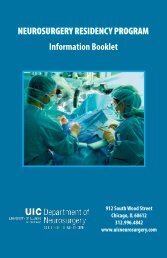
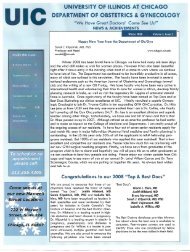
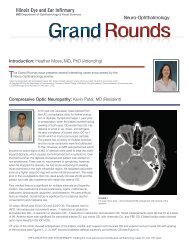
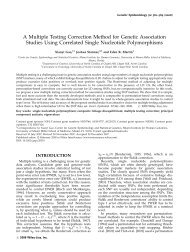

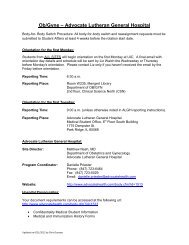


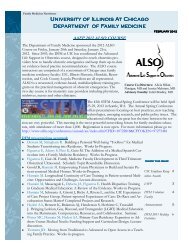
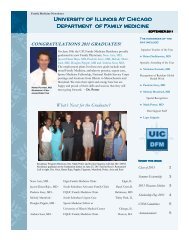
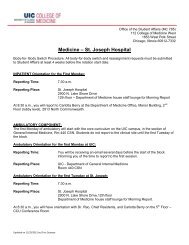
![CV Joan [W51] - University of Illinois College of Medicine at Chicago ...](https://img.yumpu.com/17336863/1/190x245/cv-joan-w51-university-of-illinois-college-of-medicine-at-chicago-.jpg?quality=85)
